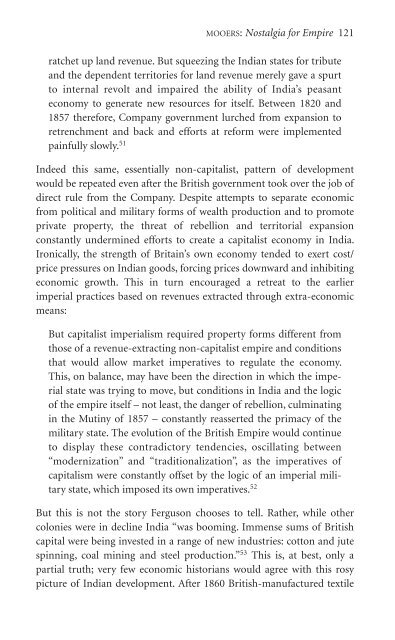New Imperialists : Ideologies of Empire
New Imperialists : Ideologies of Empire
New Imperialists : Ideologies of Empire
You also want an ePaper? Increase the reach of your titles
YUMPU automatically turns print PDFs into web optimized ePapers that Google loves.
MOOERS: Nostalgia for <strong>Empire</strong> 121<br />
ratchet up land revenue. But squeezing the Indian states for tribute<br />
and the dependent territories for land revenue merely gave a spurt<br />
to internal revolt and impaired the ability <strong>of</strong> India’s peasant<br />
economy to generate new resources for itself. Between 1820 and<br />
1857 therefore, Company government lurched from expansion to<br />
retrenchment and back and efforts at reform were implemented<br />
painfully slowly. 51<br />
Indeed this same, essentially non-capitalist, pattern <strong>of</strong> development<br />
would be repeated even after the British government took over the job <strong>of</strong><br />
direct rule from the Company. Despite attempts to separate economic<br />
from political and military forms <strong>of</strong> wealth production and to promote<br />
private property, the threat <strong>of</strong> rebellion and territorial expansion<br />
constantly undermined efforts to create a capitalist economy in India.<br />
Ironically, the strength <strong>of</strong> Britain’s own economy tended to exert cost/<br />
price pressures on Indian goods, forcing prices downward and inhibiting<br />
economic growth. This in turn encouraged a retreat to the earlier<br />
imperial practices based on revenues extracted through extra-economic<br />
means:<br />
But capitalist imperialism required property forms different from<br />
those <strong>of</strong> a revenue-extracting non-capitalist empire and conditions<br />
that would allow market imperatives to regulate the economy.<br />
This, on balance, may have been the direction in which the imperial<br />
state was trying to move, but conditions in India and the logic<br />
<strong>of</strong> the empire itself – not least, the danger <strong>of</strong> rebellion, culminating<br />
in the Mutiny <strong>of</strong> 1857 – constantly reasserted the primacy <strong>of</strong> the<br />
military state. The evolution <strong>of</strong> the British <strong>Empire</strong> would continue<br />
to display these contradictory tendencies, oscillating between<br />
“modernization” and “traditionalization”, as the imperatives <strong>of</strong><br />
capitalism were constantly <strong>of</strong>fset by the logic <strong>of</strong> an imperial military<br />
state, which imposed its own imperatives. 52<br />
But this is not the story Ferguson chooses to tell. Rather, while other<br />
colonies were in decline India “was booming. Immense sums <strong>of</strong> British<br />
capital were being invested in a range <strong>of</strong> new industries: cotton and jute<br />
spinning, coal mining and steel production.” 53 This is, at best, only a<br />
partial truth; very few economic historians would agree with this rosy<br />
picture <strong>of</strong> Indian development. After 1860 British-manufactured textile


